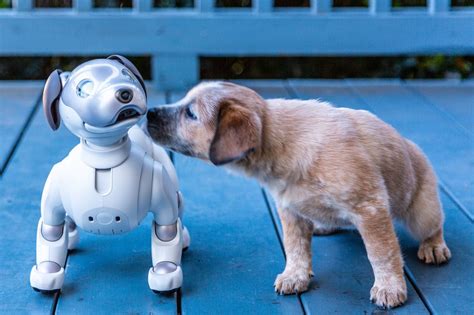Introduction

In a rapidly evolving technological landscape, the boundaries between artificial intelligence and pet ownership are becoming increasingly blurred. AI robot pets have emerged as a compelling alternative to traditional animal companions, offering unique advantages and challenges in the realm of pet socialization. This comprehensive guide delves into the nuances of AI robot pets and their impact on pet socialization in 2025 and beyond.
AI Robot Pets: Benefits and Drawbacks
AI robot pets are designed to mimic the behaviors and interactions of real animals, offering companionship, entertainment, and potential therapeutic benefits. However, they also have their limitations:
Benefits:
- Convenience: AI robot pets require minimal care and maintenance, making them ideal for busy individuals or those with limited space.
- Hypoallergenic: They do not shed or trigger allergies, providing a safe option for pet lovers who suffer from allergies.
- Programmability: AI robot pets can be programmed with specific behaviors and routines, allowing for a customized pet experience.
- Educational: They can teach children valuable lessons about responsibility, empathy, and technology.
Drawbacks:
- Emotional Connection: AI robot pets cannot fully replicate the emotional bond that develops between humans and real animals.
- Lack of Physicality: They do not require physical exercise or grooming, which can lead to a lack of stimulation.
- Dependence on Technology: AI robot pets rely on batteries or power sources, which can be limiting in certain situations.
Pet Socialization: The Importance
Pet socialization is essential for the well-being and happiness of both animal and human companions. It provides:
- Behavioral Development: Socialization helps pets learn appropriate behaviors, reducing anxiety and aggression towards other animals and people.
- Physical Exercise: Interacting with other pets encourages physical activity and play, promoting overall health.
- Mental Stimulation: Socialization provides mental stimulation and enrichment, which can prevent boredom and loneliness.
AI Robot Pets VS Real Pets: A Comparison
When it comes to pet socialization, AI robot pets and real pets offer different experiences:
| Feature | AI Robot Pets | Real Pets |
|---|---|---|
| Social Interaction | Limited to programmed scenarios | Variable and unpredictable |
| Physical Interaction | Non-existent | Essential for exercise and play |
| Emotional Connection | Simulated or artificial | Can be deep and long-lasting |
| Independence | Highly dependent on technology | Somewhat independent, but still require care |
| Socialization Opportunities | Restricted to other AI robot pets | Wide range of opportunities (e.g., parks, dog parks, pet events) |
Impact of AI Robot Pets on Pet Socialization
The increasing popularity of AI robot pets could have potential implications for pet socialization:
Positive Effects:
- Increased Awareness: AI robot pets can raise awareness about the importance of pet socialization and encourage responsible pet ownership.
- Alternative Solutions: They can provide socialization opportunities for individuals who are unable to care for real pets due to circumstances or allergies.
Negative Effects:
- Reduced Interactions: Over-reliance on AI robot pets could lead to decreased social interactions between real pets and their owners.
- False Expectations: Children may develop unrealistic expectations of pet ownership based on the highly controlled experiences provided by AI robot pets.
The Future of Pet Socialization
In 2025 and beyond, the relationship between AI robot pets and pet socialization is likely to evolve further.
Advancements in Technology: AI robot pets will become more sophisticated, offering more realistic interactions and fostering a stronger bond with their owners.
Integration of Technologies: AI robot pets could be integrated with other technologies, such as virtual reality and augmented reality, to create immersive socialization experiences.
New Applications: AI robot pets could be used in innovative ways to promote pet socialization, such as in therapy and education settings.
Conclusion
AI robot pets offer unique advantages and challenges in the realm of pet socialization. While they cannot fully replace the companionship and emotional bond of real animals, they can provide alternative solutions and facilitate pet socialization opportunities for individuals who may otherwise be unable to experience it. As technology continues to advance, it is crucial to consider the potential impact of AI robot pets on pet socialization and to find ways to leverage their benefits while mitigating any potential drawbacks.





















